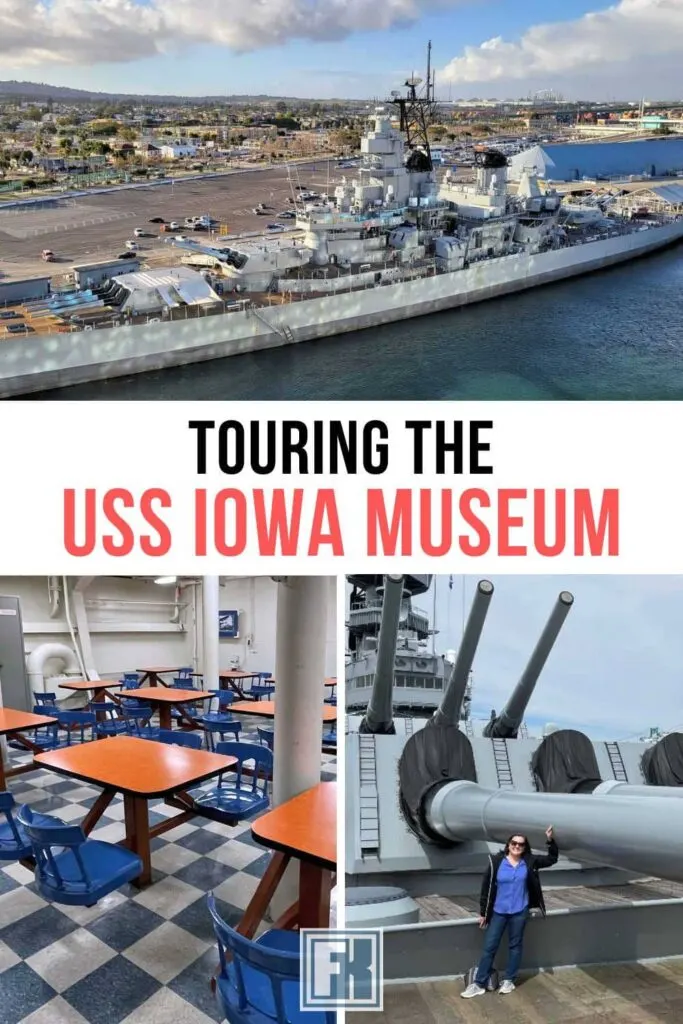
Visiting the USS Iowa Museum provides a journey spanning several decades. Envision a behemoth of the seas, a vessel spanning nearly three football fields, armed with guns of colossal proportions.
Beyond the main deck, you’ll find many nooks and crannies begging for exploration. During your self-guided tour, you can learn a tangible piece of U.S. history and discover the incredible journey of this majestic battleship.
The USS Iowa Museum, nestled in the Port of Los Angeles, has silently witnessed countless pivotal moments in maritime history.
Examples include safely ferrying President Roosevelt across the tumultuous Atlantic to asserting its might in significant global conflicts. Today this giant of the seas exists to educate the public about its nearly 50-year history in service.
We visited the Iowa Museum the day before embarking on our Pacific Coastal Cruise. This 7-day cruise was aboard the Celebrity Solstice, including San Francisco, Santa Barbara, San Diego, and Ensenada as ports of call.
We arrived in Los Angeles a day early because we wanted to do the USS Iowa tour. Whenever we cruise, we love adding a day or two at the front or back to discover the home port.
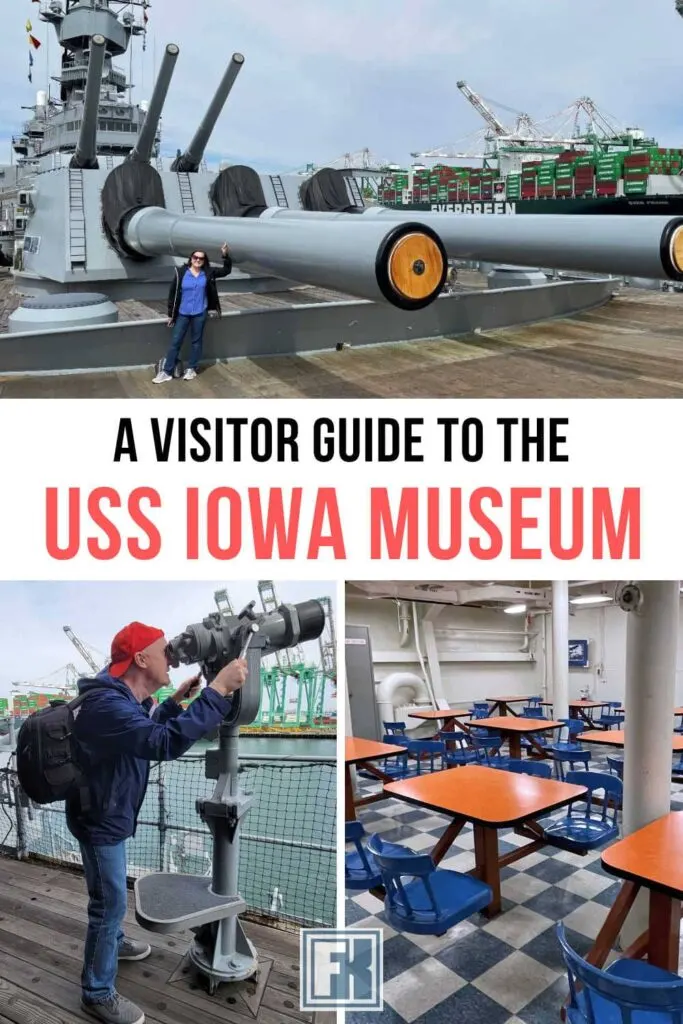
The museum has many exhibits, enthralling historical accounts, and immersive experiences. When you visit, you’ll delve deep into U.S. naval history and learn unusual facts, like why it has the only bathtub on a battleship.
Getting To The Battleship USS Iowa Museum
The California battleship is located at 250 S. Harbor Boulevard, an iconic Los Angeles landmark. This is in the San Pedro neighborhood, about 40 minutes south of L.A. International Airport (LAX).
We flew from Vancouver into LAX and took an Uber ride-share to our hotel, the Crowne Plaza, which was within walking distance of the USS Iowa Museum. The Uber ride was about USD 50.
The museum is open daily from 10 am – 4 pm. However, their website shows the hours as 10 am – 5 pm. You can purchase the last ticket at 4 pm, and you must leave the museum by 5 pm.
Once onboard, you can follow a group on a guided tour or browse at your own pace. Ticket prices, at the time of this writing, are as follows:
| Adult (12-61) | USD 25.95 |
| Senior (62+) | USD 22.95 |
| Military (Active Duty and Vets with ID) | USD 22.95 |
| Youth (3-11) | USD 17.95 |
| Child (under 3) | No charge |
We chose to buy tickets at the entrance on the day of our visit. Since the ship is massive, you would be unlikely to be turned away due to attendance being at maximum capacity.
Before your visit, it’s a good idea to download the Battleship Iowa app. The mobile app elevates your experience by providing an audio guide, fun facts, stories, and details about the whole ship. Techies will love the app and its augmented reality features.
A tour of Iowa is suitable for the whole family. In fact, throughout the ship, you’ll find references to its mascot dog called “Vicky.” Using the complimetary app, young children can enjoy a dog scavenger hunt to find the little dog at multiple venues throughout the ship.
Historical Significance
The USS Iowa (BB-61), the lead ship of her battleship class, played a significant role in the United States Navy during her more than 50 years of service. This US Navy battleship saw action in World War II, the Korean War, and the Cold War era.
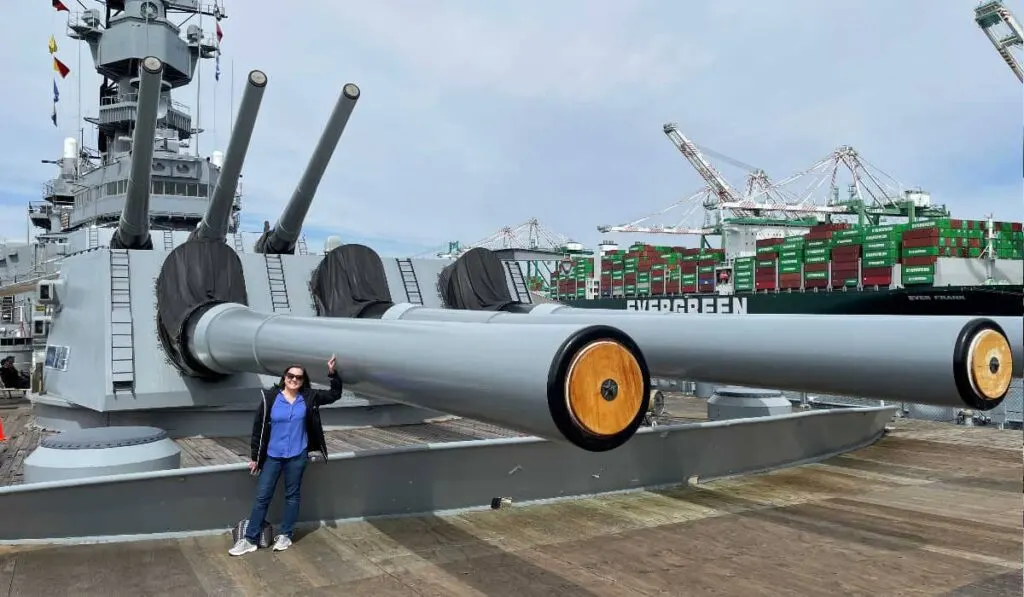
Launched on August 27, 1942, and commissioned on February 22, 1943, the USS Iowa served in both the Atlantic and Pacific Theaters of World War II. During her service, she was a formidable force with her advanced radar systems and heavy artillery, notably her nine 16-inch guns.
Known as the Battleship of Presidents, the USS Iowa safely transported President Franklin D. Roosevelt in 1943. He attended the Tehran Conference, where he met with Winston Churchill and Joseph Stalin to plan strategy.
For this voyage, a bathtub was installed for the President’s use, making Iowa the only battleship with a bathtub.
After World War II, the USS Iowa was decommissioned but was later reactivated for the Korean War. She conducted gun strikes against enemy targets and provided gunfire support for UN forces on the ground, asserting her significance again.
The USS Iowa was decommissioned and recommissioned several times as the geopolitical landscape shifted during the Cold War. Her last stint in active service started in the 1980s when she was modernized under the 600-ship Navy initiative.

The ship was equipped with missile systems and other advanced weaponry, reinforcing her status as a symbol of American naval power.
In 1989, the USS Iowa suffered a tragic incident when an explosion in one of the main gun turrets killed 47 crew members. The incident led to significant changes in Navy policy and procedure.
The battleship was decommissioned for the last time in 1990 and remains a floating museum on the Los Angeles waterfront. The regional attraction serves as a vital piece of naval history and an educational resource.
Unique Features Of The USS Iowa Museum
The USS Iowa (BB-61) is the lead ship of her battleship class and is one of the most powerful battleships ever built.
Other ships in the Iowa class include the USS New Jersey (BB-62), USS Missouri (BB-63), and the USS Wisconsin (BB-64). All were commissioned in 1943/44. We had previously toured the USS Missouri in Pearl Harbor and found many similarities between the ships.

The USS Iowa measures approximately 887 feet 3 inches (270 m) in length, with a beam (width at the broadest point) of approximately 108 feet 2 inches (33 m).
The ship has a draft of about 37 feet 2 inches (11.3 m), meaning this is how much of the ship’s hull is below the waterline.
In terms of displacement, the USS Iowa is massive. In World War II, she had a standard displacement (the weight of the ship excluding cargo, fuel, etc.) of 45,000 tons. This resulted in a full-load displacement of around 57,500 tons.
The ship’s main armament consists of nine 16-inch (406 mm) / 50 caliber Mark 7 guns, among the most powerful naval guns ever on a U.S. warship. These guns are grouped into three-gun turrets, two forward and one aft.
Additionally, the USS Iowa has numerous secondary armaments to accompany her big guns,. In her World War II configuration, she had twenty 5-inch (127 mm) / 38 caliber Mark 12 guns for dealing with smaller surface targets and aircraft and an array of anti-aircraft weaponry.
In the 1980s, the Navy modernized the vessel with Tomahawk cruise missile launchers, Harpoon anti-ship missile launchers, and Phalanx close-in weapon systems (CIWS) for defense against incoming missiles.

If you are fascinated by the engineering of vessels like the USS Iowa, here are some facts that you may find interesting.
- Powered by four propeller shafts and eight Babcock & Wilcox boilers, connected to four General Electric geared steam turbines.
- Total of 212,000 shaft horsepower, propelling the ship at speeds of over 30 knots (35 mph; 56 km/h).
- Crew complement of about 1,921 (during World War II), which later expanded to around 2,700 after her 1980s refit due to the increased demands of her new systems and weaponry.
- The Navy designed Iowa as a flagship, so she has additional facilities for a fleet admiral and his staff.
Additionally, the ship carried several floatplanes (like the Vought OS2U Kingfisher) on catapults for scouting and rescue purposes. During the post-World War II period, the Navy phased the floatplanes out of service.
It’s important to note that the specifics of the ship’s equipment and layout changed several times over her career, reflecting advancements in technology and changes in her intended mission.
Transformation To A Museum
The USS Iowa (BB-61) has had a distinguished career and has become one of the most decorated battleships in the history of the U.S. Navy.
After serving for nearly half a century, the world-famous ship was retired and left in a state of mothballs. However, as you can see, she had bigger plans than a quiet retirement.
Her legacy was far from over; instead, she entered a new chapter – as a museum. Inside the wardroom, you learn its history, before exploring the vessel.

After a period in the U.S. Navy’s reserve fleet, it was removed from the Naval Vessel Register in 2006, making it available for donation as a museum ship.
At this juncture, the non-profit Pacific Battleship Center entered the picture. The group proposed turning the USS Iowa into a floating museum, and after a successful lobbying effort, the Navy awarded them the ship in 2011.
One of the most critical aspects of the transformation was physically moving Iowa to its new home. In October 2011, Iowa began a massive, four-month refurbishment project at the Port of Richmond in Northern California.
Here, the Pacific Battleship Center did a comprehensive overhaul, restoring her to her former glory. Then, in May 2012, the USS Iowa undertook her final journey, a 400-mile tow down the west coast to the Port of Los Angeles.
During her transformation, a beautiful stained glass window was recovered. It was initially installed in the ship’s chapel. Today, you can see it in the Wardroom.

The real transformation began once at her new berth on the LA waterfront. The Pacific Battleship Center, with help from numerous volunteers, worked tirelessly to convert the vessel into a museum.
They cleared spaces, set up displays, and created numerous exhibits. Areas of the ship that had been closed for decades were opened, revealing insights into life on a battleship.
From the enormous 16-inch gun turrets to the captain’s cabin and even the unique bathtub installed for President Roosevelt, each area of the ship was carefully curated to educate visitors about the ship’s history and the broader context of naval warfare.
Opening To The Public
On July 7, 2012, after months of preparation, the USS Iowa Museum officially opened to the public. Since then, it has been a significant draw for history enthusiasts, students, and tourists.

The transformation of the USS Iowa from a battleship into a museum has allowed her legacy of service to continue in a new, educational capacity.
Planning a visit to the USS Iowa can be a memorable experience! On your visit, you can walk in the footsteps of sailors, see the missile decks, and browse the living spaces.
Allow several hours if you want to see everything. The museum offers guided tours that can provide valuable historical context and highlight key features of the ship that you might miss on your own.
As the USS Iowa is a large warship, you’ll be doing a lot of walking, including climbing steep stairs. Due to its historic nature, the ship is not entirely ADA-accessible, so comfortable footwear is a must.
Also, consider the weather, as you’ll be exposed to the elements on the ship’s upper decks.
Be aware that visiting a historic warship like the USS Iowa will have inherent safety considerations. Pay attention to uneven decking, low ceilings, step-through doorways, and steep staircases.

If you’re arriving in California to cruise from one of LA’s ports, allow time to see the battleship or other nearby attractions. Additional points of interest include the Los Angeles Maritime Museum and Cabrillo Marine Aquarium. Consider incorporating these into your visit.
Highlights Of The Tour
As you wander the hallways, you’ll feel like you are touring a maze, with corridors and doors in all directions. I can’t imagine how long it would take to learn the layout, deck by deck.
There is much to see when touring the Military Museum. You will have your own things that pique your interest during your visit.
Here are some areas of the ship we enjoyed.
Officers’ Accommodation – It was fascinating to see the relative luxury the ship’s officers enjoyed. Although, since Karen and I have traveled on modern cruise ships, we found the officers’ wardroom spartan at best.

Lost at Sea Memorial – This area is on the lower deck and pays tribute to many significant historical naval events. You can learn about some maritime history disasters that have defined the last century through large graphics, photos, and artifacts.
HMHS Britannic, HMS Hood, USS Yorktown, and the USS Scorpion are some of the vessels featured in this display.
We did not see this when touring the sister ship, USS Missouri, in Pearl Harbor. I found it interesting, and well done!
Enlisted Accommodation – In stark contrast to the generous cabin the officers enjoy, the crew quarters feature bunks stacked three above each other. I’m not tall, but I can’t imagine sleeping in that tiny bunk for weeks or months on end!

Food Services – There are several displays throughout the ship with life-size mannequins staring at you. It helped you imagine what dining would be like on this massive ship.
With a regular crew of 1,500 sailors, I can imagine the work and supplies needed to keep them fed!
Dining Areas – The enlisted men would eat three meals a day in these large open areas. The spaces were clean and spacious. What was missing was the loud “roar” of hungry sailors devouring their meals and talking with tablemates.
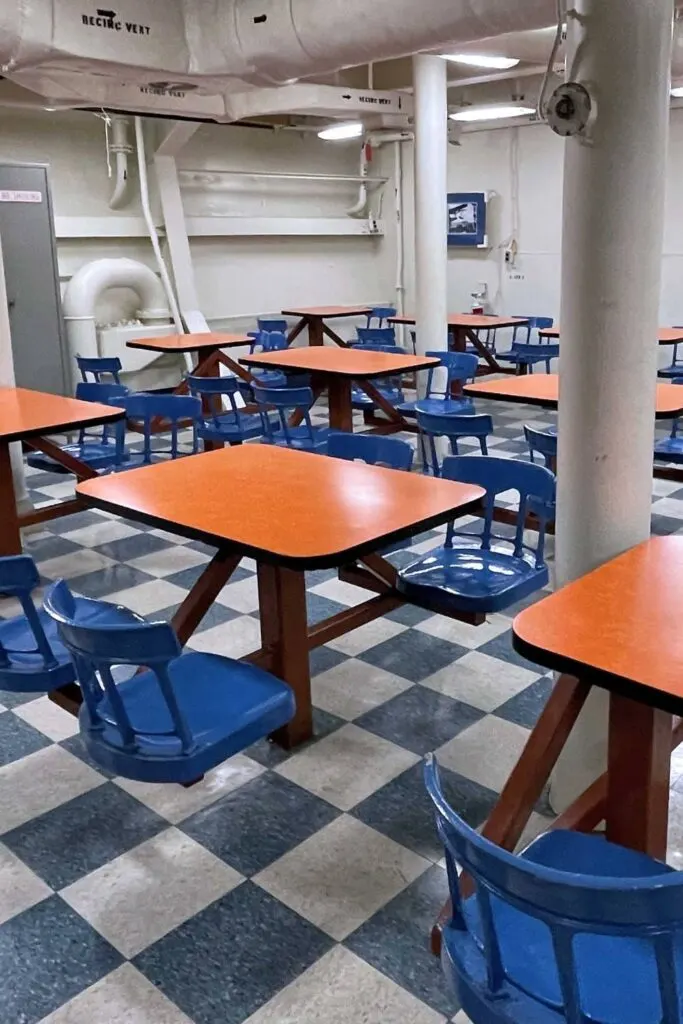
Like the USS Missouri, the dining tables doubled as surgical tables during medical procedures.
Crew Services – It was fascinating to see the many services needed for the life of a sailor. The barber shop was open daily at certain times and occasionally to the public for haircuts.
The barber shop’s claim to fame is having the sitting President George H. W. Bush get his haircut while visiting. Other services included a cobbler (shoe repair) and a laundry/dry cleaner.
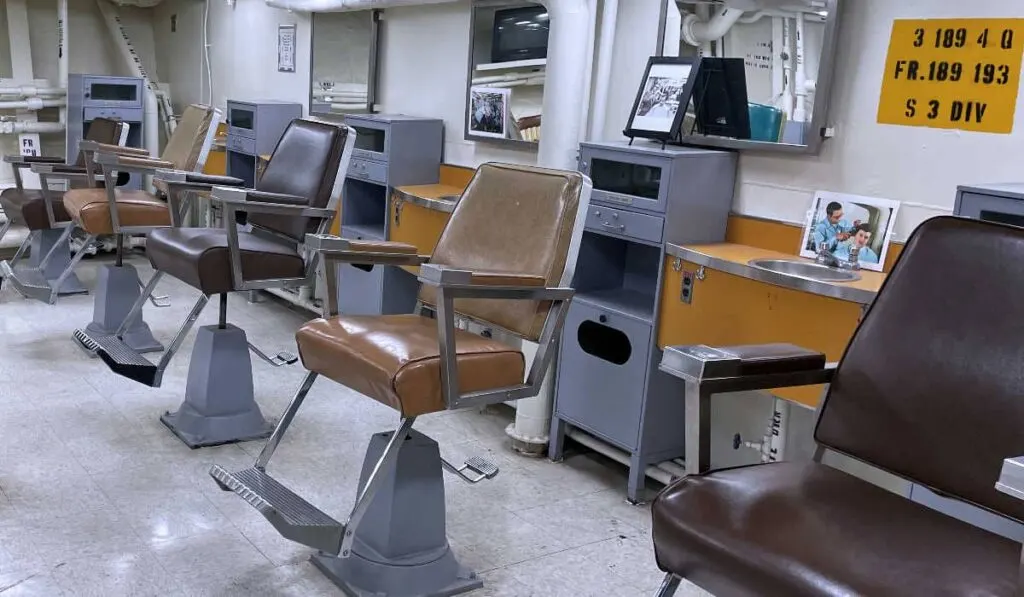
Other Exhibits And Displays
Throughout the ship, here are some exhibits and displays you could expect to see at the USS Iowa Museum:
President Roosevelt’s Cabin – The Navy built this cabin for President Franklin D. Roosevelt during World War II. It is unique because it had to accommodate the president’s wheelchair.
The Bridge – This is the ship’s command center where the captain and officers would have controlled the vessel.
Gun Turrets – These are the massive gun turrets that once fired 16-inch shells, some of which weighed as much as a small car.
Tomahawk Cruise Missile Launchers – The Navy retrofitted USS Iowa with these in the 1980s.
Phalanx CIWS – This is a close-in weapon system for defense against anti-ship missiles.
The Veteran’s Museum – This area on the ship pays tribute to all US military branches and includes a Wall of Honor for local servicemen and servicewomen.
Aircraft – Several aircraft types are on display, such as a Kingfisher floatplane. During our visit, the only aircraft was a helicopter.
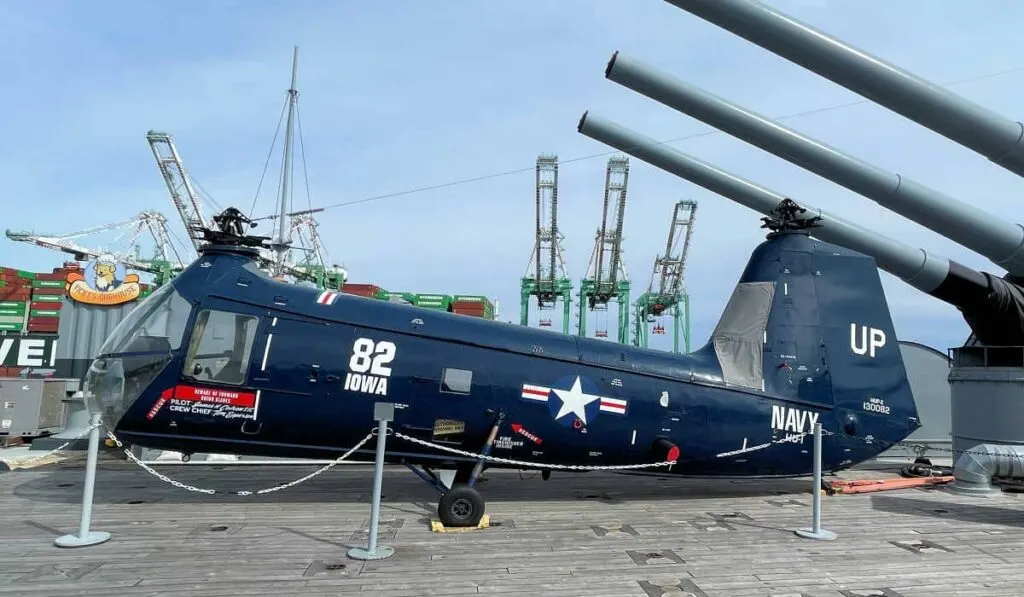
Interactive Exhibits – Visitors can experience life aboard a battleship by immersing themselves in interactive exhibits throughout the ship.
Before you go, check the museum’s official website or contact them directly for the most up-to-date and detailed information about current exhibits and displays.
Impact On The Local Community
The California battleship in San Pedro has considerably impacted its local community in several ways. Firstly, since it opened as a museum, the USS Iowa has attracted tourists worldwide, boosting local businesses such as hotels, restaurants, and shops.
Tourists contribute to the local economy and help create jobs.
Secondly, the USS Iowa Museum offers educational programs and resources for students of all ages. It provides an immersive experience where visitors can learn about naval history, technology, and the military’s role in American and world history.
It provides an essential educational resource for local schools and educators.
The museum organizes various special events, activities, and community programs. These activities foster a sense of community and offer locals a unique venue for gatherings and celebrations.

During our visit, workers were taking down tents, chairs, and other gear used to host a community event the day earlier.
Like most museums, you will arrive at a gift shop as part of your tour. This is the ideal place to get an authentic souvenir for yourself or something for friends and family.
By preserving and presenting the history of the USS Iowa, the museum helps the community understand and appreciate the past.
The museum also provides support and recognition for veterans. It serves as a hub for local veteran communities and hosts events and activities dedicated to honoring the service of these individuals.
This helps to strengthen community ties and provides essential recognition and support for veterans.
Final Thoughts
This was our second visit to an Iowa-class battleship, as we had visited the USS Missouri in Pearl Harbor, Hawaii, years earlier. The ships are almost identical, but I found the Hawaiian location of the Missouri instilled a somber mood because of the Japanese attack 75 years ago.
However, the USS Iowa Museum had the added value of the Lost At Sea memorial on the lower deck. Even though I have never served in any military, I felt a sense of “awe” for the lives risked and lost.
While the Navy launched the USS Iowa 80 years ago, it continues to instill a sense of wonder for the history she has lived. With the addition of a clever mascot dog named “Vicky,” dog lovers may find an additional connection to the retired vessel.
The museum is a must-see destination if you are a Californian or ever traveling to the Los Angeles area. So, if you’ve ever wanted to see, give yourself a half-day to take in all decks and every detail of this magnificent piece of naval history.
